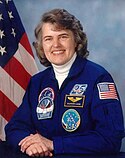Shannon Lucid
| Shannon Lucid | |
|---|---|
 | |
| NASA Astronaut | |
| Statsborger | USA |
| Nationalitet | Amerikaner |
| Født | 14. januar 1943 Shanghai, Kina |
Andet arbejde | Biokemi |
| Uddannelses- sted | Bethany High School University of Oklahoma |
| Udvælgelse | NASA Årgang 1978 |
| Mission(er) | STS-51-G, STS-34, STS-43, STS-58, STS-76, STS-79 |
| Missionsemblemer | |
Shannon Matilda Wells Lucid født 14. januar 1943, er en amerikansk astronaut. Hun har sat rekord som den kvinde der har været længst tid i rummet, i 188 døgn, det skete mens hun var om bord på rumstationen Mir i 1996. Rekorden varede til 2007 hvor Sunita Williams satte ny rekord på 195 døgn. Peggy Whitson har nuværende rekord2008.
Af uddannelse er hun Biokemiker og fik doktorgrad i 1973, og begyndte på astronaut-uddannelse i 1974 hos NASA. Hendes første rumfærgeflyvning var i 1985 og hendes sidste var i 1996.
Senest har hun været på kontrolcenteret i Houston som den der har kommunikationen (capcom) med besætningen på de bemandede rumflyvninger. Hun har haft rollen som capcom på følgende missioner: STS-114 i 2005, STS-116 i 2006, STS-118, STS-120 i 2007 og STS-122 og STS-124 i 2008.
Se også
Eksterne henvisninger
- Astronaut Shannon Lucid Arkiveret 2. juli 2008 hos Wayback Machine NASA (engelsk)
| Spire Denne artikel om rumfart er en spire som bør udbygges. Du er velkommen til at hjælpe Wikipedia ved at udvide den. |
|
Medier brugt på denne side
A drawing of NASA's Space Shuttle Challenger. Image provided by Dryden Flight Research Center at Edwards Air Force Base, California. See [1], specifically EG-0076-04.eps.
STS-34 Mission Insignia
Shannon Lucid
Shuttle mission 51-G patch
- The STS-51G insignia illustrates the advances in aviation technology in the United States within a relatively short span of the twentieth century. The surnames of the crewmembers for the Discovery's mission appear near the center edge of the circular design.
STS-43 Mission Insignia
- Designed by the astronauts assigned to fly on the mission, the STS 43 patch portrays the evolution and continuity of the USA's space program by highlighting 30 years of American manned space flight experience -- from Mercury to the Space Shuttle. The emergence of the Shuttle Atlantis from the outlined configuration of the Mercury space capsule commemorates this special relationship. The energy and momentum of launch are conveyed by the gradations of blue which mark the Shuttle's ascent from Earth to space. Once in Earth orbit, Atlantis' cargo bay opens to reveal the Tracking and Data Relay Satellite (TDRS) which appears in gold emphasis against the white wings of Atlantis and the stark blackness of space. A primary mission objective, the Tracking and Data Relay Satellite System (TDRSS) will enable almost continuous communication from Earth to space for future Space Shuttle missions. The stars on the patch are arranged to suggest this mission's numerical designation, with four stars left of Atlantis and three to the right.
STS-58 Crew Insignia
STS-76 Mission Insignia








